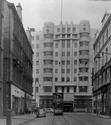 By 1914 central Glasgow had possibly the most American-like city centre in Europe: grid-iron streets surged up and down hills faced by ever taller red stone-faced commercial buildings. Between the wars that resemblance was intensified in large commercial buildings or banks, principally either at the western edge of the city centre or in the Merchant City.
By 1914 central Glasgow had possibly the most American-like city centre in Europe: grid-iron streets surged up and down hills faced by ever taller red stone-faced commercial buildings. Between the wars that resemblance was intensified in large commercial buildings or banks, principally either at the western edge of the city centre or in the Merchant City.
 Wylie & Wright's eight storeyed steel-framed Scottish Legal Life building, Bothwell Street (1927), occupies an entire city block. Its architecture is thunderously American classical: four principal storeys (with the facade peeled back) above a two-storeyed rusticated plinth and below a two storeyed attic. A G Henderson changed from overblown Beaux-Arts neo-classicism at Glasgow Cross (from 1920) to unconvincing American in the Bank of Scotland, Sauchiehall Street (1931). James Taylor Thomson designed a number of more authentically American warehouses on corner sites in the Merchant City, e.g. 71 Candleriggs (1931), identifiable by height, spare carving and sleek, red stone verticality. In Albion Street, the black and white curtain-walled Sir E Owen Williams' Daily Express building (1936) was an inconsequential stranger in the tougher American atmosphere of Glasgow.
Wylie & Wright's eight storeyed steel-framed Scottish Legal Life building, Bothwell Street (1927), occupies an entire city block. Its architecture is thunderously American classical: four principal storeys (with the facade peeled back) above a two-storeyed rusticated plinth and below a two storeyed attic. A G Henderson changed from overblown Beaux-Arts neo-classicism at Glasgow Cross (from 1920) to unconvincing American in the Bank of Scotland, Sauchiehall Street (1931). James Taylor Thomson designed a number of more authentically American warehouses on corner sites in the Merchant City, e.g. 71 Candleriggs (1931), identifiable by height, spare carving and sleek, red stone verticality. In Albion Street, the black and white curtain-walled Sir E Owen Williams' Daily Express building (1936) was an inconsequential stranger in the tougher American atmosphere of Glasgow.
 The architects most responsible for Glasgow's continuing Americanisation were James Miller and his assistant, Richard Gunn, beginning with the majestic, heavily-corniced stone pile of the Union Bank HQ (later Bank of Scotland), St Vincent Street (1924). Behind its giant Ionic columns, the stone walls of its lower half are pulled back into glazing, with a central entrance of Egyptian grandeur. Its freedom from classical conventions, by comparison with the more traditional stone classic 200 St Vincent Street by J J Burnet (1925) is striking. Miller's next design, the tall, supremely elegant, white Commercial Bank, 92 West George Street (1930), is probably his best, although his Commercial Bank, Bothwell Street (1924) was his most inventive.
The architects most responsible for Glasgow's continuing Americanisation were James Miller and his assistant, Richard Gunn, beginning with the majestic, heavily-corniced stone pile of the Union Bank HQ (later Bank of Scotland), St Vincent Street (1924). Behind its giant Ionic columns, the stone walls of its lower half are pulled back into glazing, with a central entrance of Egyptian grandeur. Its freedom from classical conventions, by comparison with the more traditional stone classic 200 St Vincent Street by J J Burnet (1925) is striking. Miller's next design, the tall, supremely elegant, white Commercial Bank, 92 West George Street (1930), is probably his best, although his Commercial Bank, Bothwell Street (1924) was his most inventive.
Consequently, from some perspectives, George Square, Glasgow could resemble City Square, Chicago, and Renfield or St Vincent Streets their equivalents in Seattle or Portland.